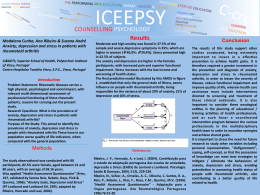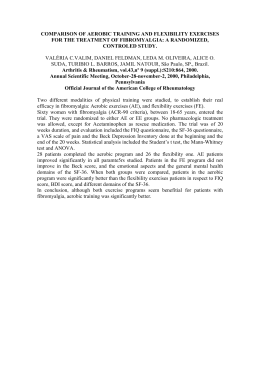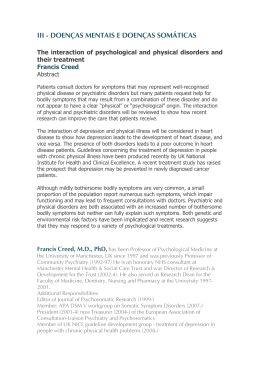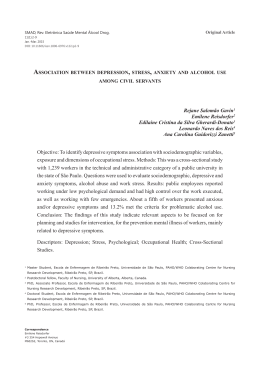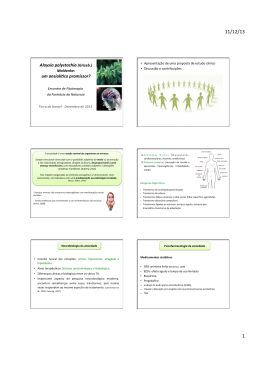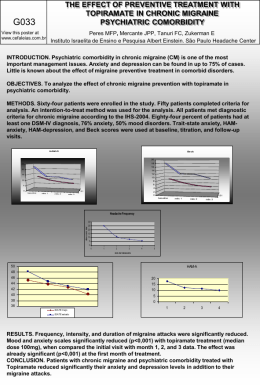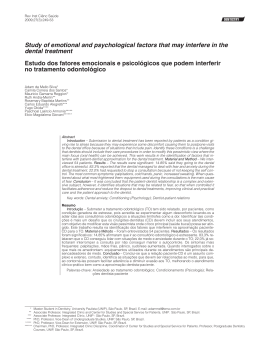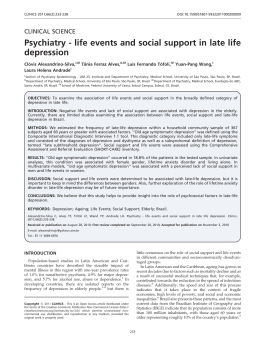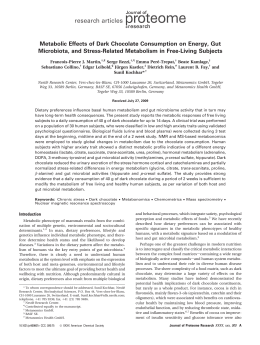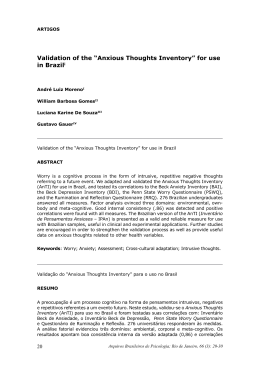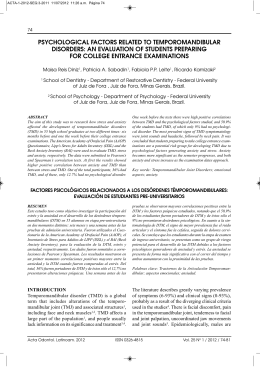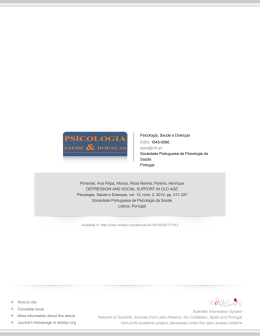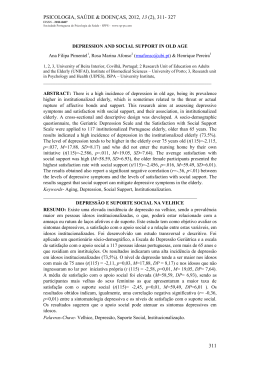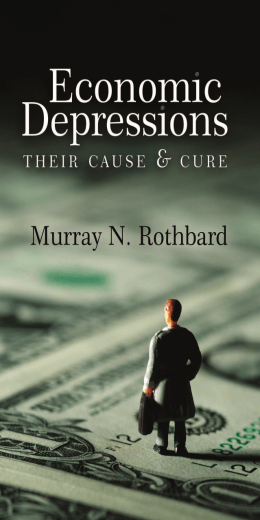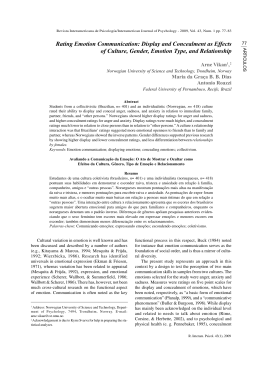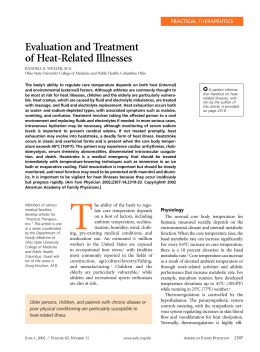R E V B R A S R E U M AT O L . 2 0 1 3 ; 5 4 ( 1 ) : 2 7 – 3 2 REVISTA BRASILEIRA DE REUMATOLOGIA www.reumatologia.com.br Original article Investigation of stress, anxiety and depression in women with fibromyalgia: a comparative study Fernanda de Souza Ramiroa, Império Lombardi Júniorb, Regina Claudia Barbosa da Silvac, Fábio Tadeu Montesanoa, Nara Rejane Cruz de Oliveirab, Ricardo Edésio Amorim Santos Dinizd, Paulo Augusto Alambertd, Ricardo da Costa Padovanie,* Universidade Federal de São Paulo (UNIFESP), Santos, SP, Brazil Department of Human Movement Sciences, Universidade Federal de São Paulo (UNIFESP), Santos, SP, Brazil c Department of Biosciences, Universidade Federal de São Paulo (UNIFESP), Santos, SP, Brazil d Universidade Metropolitana de Santos (UNIMES), Santos, SP, Brazil e Department of Health, Educação e Sociedade, Universidade Federal de São Paulo (UNIFESP), Santos, SP, Brazil a b article info abstract Article history: Introduction: Depression has emerged as the most prevalent mental disorder in patients Received on 14 September 2012 with fibromyalgia. Stress, whose stages are alarm, resistance, near-exhaustion and exhaus- Accepted on 16 April 2013 tion, constitutes a physical reaction to a threatening situation. Objective: To investigate the levels of stress, anxiety and depression in women with fibromy- Keywords: algia, comparing them with those of healthy women. Fibromyalgia Patients and methods: Participants were 50 women, 25 with a diagnosis of fibromyalgia ac- Stress cording to the criteria of the American College of Rheumatology, and 25 without this diag- Anxiety nosis, matched for age. Instruments used: Lipp Inventory of Stress Symptoms for Adults Depression (LISS), State-Trait Anxiety Inventory (STAI) and Beck Depression Inventory (BDI). Woman Results: The mean age was 49.36 years for the group with fibromyalgia (FM) and 49.20 years for the group without fibromyalgia (non-FM). FM showed a higher incidence of stress (96%) compared with non-FM (5%). The resistance phase was predominant in both groups, FM (42%) and non-FM (100%). In FM there was distribution of the four stages (alarm, resistance, near-exhaustion and exhaustion). The differences between phases in the analyzed groups were significant (p < 0.001). FM showed predominance of psychological symptoms (54%); non-FM did show the same frequency of psychological and physical/psychological (40%) symptoms. Symptoms of state and trait anxiety and of depression in FM were significantly higher, when compared with non-FM (p < 0.01). Conclusion: Stress index (96%), trait anxiety (over 50) and clinically relevant depression (greater than 20) in FM were relevant. The understanding of the emotional variables involved in fibromyalgia is important to define the therapeutic strategy. © 2014 Elsevier Editora Ltda. All rights reserved. * Corresponding author. E-mail: [email protected] (R.C. Padovani). 0482-5004/$ - see front matter. © 2014 Elsevier Editora Ltda. All rights reserved. http://dx.doi.org/10.1016/j.rbre.2014.02.003 28 R E V B R A S R E U M AT O L . 2 0 1 3 ; 5 4 ( 1 ) : 2 7 – 3 2 Investigação do estresse, ansiedade e depressão em mulheres com fibromialgia: um estudo comparativo resumo Palavras-chave: Introdução: A depressão tem se apresentado como o transtorno mental mais prevalente em Fibromialgia pacientes com fibromialgia. O estresse, cujas fases são alarme, resistência, quase-exaustão Estresse e exaustão, constitui importante reação do organismo frente a uma situação ameaçadora. Ansiedade Objetivo: Investigar os índices de estresse, ansiedade e depressão em mulheres com fibro- Depressão mialgia, comparando-os com os de mulheres saudáveis. Mulher Pacientes e métodos: Participaram 50 mulheres, 25 com o diagnóstico de fibromialgia, segundo os critérios do American College of Rheumatology, e 25 sem o diagnóstico, pareadas por idade. Instrumentos utilizados: Inventário de Sintomas de Stress para Adultos de Lipp (ISSL), Inventário de Ansiedade Traço-Estado (IDATE) e Inventário de Depressão Beck (BDI). Resultados: Idade média de 49,36 anos para o grupo com fibromialgia (FM) e 49,20 anos para o grupo sem fibromialgia (não FM). O FM apresentou maior incidência de estresse (96%) quando comparado com o não FM (5%). A fase de resistência foi predominante nos dois grupos, FM (42%) e não FM (100%). No FM verificou-se distribuição nas quatro fases (alerta, resistência, quase-exaustão e exaustão). As diferenças entre as fases nos grupos analisados foram significativas (p<0,001). O FM apresentou predominância de sintomas psicológicos (54%), o não FM apresentou a mesma frequência de sintomas psicológico e físico/psicológico (40%). Os sintomas de ansiedade estado e traço e depressão do FM foram significativamente superiores, quando comparados com o não FM (p<0,01). Conclusão: Constatou-se índice de estresse (96%), traço de ansiedade (superior a 50) e depressão clinicamente (superior a 20) relevantes no FM. O entendimento das variáveis emocionais envolvidas na fibromialgia é importante na definição da terapêutica. © 2014 Elsevier Editora Ltda. Todos os direitos reservados. Introduction Fibromyalgia is a complex syndrome characterized by diffuse and chronic musculoskeletal pain, and by specific painful sites on palpation, called tender points.1 This syndrome is most prevalent in women aged between 40 and 55 years.2 Other symptomatic aspects are fatigue, morning stiffness, sleep disturbances, cognitive impairment, depression and anxiety.2-7 Among the mental disorders, the latter two appear as the most prevalent.2,3,8,9 The negative impact of fibromyalgia on quality of life is evident,3 a fact that causes the presence of high levels of stress, especially in women with this disease, compared with those without this diagnosis.10 In addition, studies show that women are more exposed to stress situations, both for its biological condition as for the cultural roles that, historically, society imposes on them.11,12 Psychopathological processes, such as depression and anxiety, are related both to the characteristics of the stressor event and to the cognitive processing used by the individual to interpret them, as central elements of stress.13 Therefore, it is evident the role of cognitive mediation in triggering the stress and its effects, as well as in its confrontation.14-16 In this study, stress is understood as a set of complex psychophysiological and behavioral responses, the genesis of which is in the need to establish the body's internal homeostasis, when facing a threatening situation.14 The imbalance occurs when the body needs to respond to any demand that exceeds its adaptive capacity. Significant changes generate the need of adaptation of the organism and thus exert a decisive role in the pathogenesis of stress.13,14,17 In fibromyalgia, it can be stated that all of its symptoms are beyond the adaptive capacity of the organism.2,3,10 The three-phase evolution model of stress, proposed by Hans Selye in 1956, suggests that the stress process comprises three phases: alarm, resistance and exhaustion.13 However, in the validation of the Lipp Inventory of Stress Symptoms of Adults (LISS), a fourth phase was identified, between resistance and exhaustion, which was called near-exhaustion.18 At this point, the individual demonstrates significant clinical symptomatology, although has not reached complete exhaustion yet. It is noteworthy that the alert phase is considered the positive phase of stress. The body produces adrenaline and noradrenaline, generating energy and motivation. The homeostasis breakdown at this stage does not seek to maintain, but to cope, with the challenging situation. However, if stress persists, the resistance phase will be induced. During the body attempt of adaptation, the individual begins to show a feeling of waste and fatigue. If the stressor event persists, the body's energy reserve ends up exhausted, affecting the immune system.13,18 Considering the impact of the variables of emotional order in the aggravation of the symptoms of fibromyalgia, and seeking to deepen the understanding of such variables, this study aimed to investigate the indexes of stress, anxiety and depression in women with fibromyalgia versus healthy women. Patients and methods This is a cross-sectional comparative study of quantitative approach. The research was conducted in accordance with 29 R E V B R A S R E U M AT O L . 2 0 1 3 ; 5 4 ( 1 ) : 2 7 – 3 2 the Resolution of the Ministério da Saúde No. 196/96 of the Conselho Nacional de Saúde and with the deliberation of the Ethics Committee of UNIFESP (CEP 1785/10). Sample The study included 50 women divided into two groups: 25 with a diagnosis of fibromyalgia (FM), according to the criteria of the American College of Rheumatology (ACR),1 coming from a university medical school, and 25 without a diagnosis of fibromyalgia (non-FM), matched for age and coming from the community. The inclusion criteria were: age between 20 and 65 years, absence of cognitive deficits and interest in participating in the study. For the sample size, a minimum significant difference between groups of 10 points on the Beck Depression Inventory (BDI) was defined.19 BDI was set as a criterion for performing the sample size calculation, because depression is one of the most common comorbidities in patients with fibromyalgia.2,3,8 We established the standard deviation of 8.7 points for the fibromyalgia group and 4.3 for the group without such a diagnosis. With a significance level at 0.05 and a power of 80%, it was found that the sample should have at least 24 subjects in each group.20 Thus, a total of 25 women in each group met the criteria of sample size calculation, and also made possible a safety margin in the recruitment of the number of voluntaries. Instruments A) Lipp Inventory of Stress Symptoms for Adults (LISS).18 Comprising a list of physical and psychological symptoms which identify if the person has stress, at what phase of the process (alarm, resistance, near-exhaustion and exhaustion) and if his (her) symptoms are more typical of the physical or psychological dimension. LISS is structured in three sections dealing with the four phases of stress: sector 1 evaluates the alert phase (Q1); sector 2 evaluates the resistance phase and the phase of near-exhaustion (Q2); sector 3, the exhaustion phase (Q3), which enables the diagnosis of stress. The respondent is asked to indicate whether is suffering the specified stress symptom in each sector in 24 hours (Q1), one week (Q2) or a month (Q3). The evaluation is made in terms of the test’s percentage tables. The presence of stress can be seen if any of the raw scores reach certain limits (greater than 6 in Q1, greater than 3 in Q2, greater than 8 in Q3). B) State-Trait Anxiety Inventory (STAI) .21 It consists of two scales for measuring trait anxiety (STAI-T) and state anxiety (STAI-E). Each scale comprises 20 statements. It is a Likert-type instrument, with scores ranging from 1 (not at all) to 4 (extremely) for STAI-E, and from 1 (almost never) to 4 (almost always) for STAI-T. The total score of each scale ranges from 20 to 80. Higher values indicate higher levels of anxiety. C) Beck Depression Inventory (BDI) .19 It contains 21 statements that refer to cognitive and affective symptoms, somatic sensations and performance. Each statement consists of four alternatives that express levels of depressive symptoms. The higher the score, the higher the severity. Procedures We performed a survey of clinical records of fibromyalgia patients seen at a teaching clinic linked to a medicine course at a university in the city of Santos, SP. After identification, contact was made with patients to explain the purpose of the research. Of the 40 identified patients, 25 were interested in collaborating with the study. The non-FM group participants were clinically evaluated to confirm the absence of specific symptoms of fibromyalgia. For both groups the instruments were administered individually in a single session, in the sequence as they were described. Each session lasted approximately 40 minutes. Data analysis Descriptive (mean, standard deviation) and inferential analyses of the variables studied – Lipp Inventory of Stress Symptoms for Adults (LISS), State-Trait Anxiety Inventory (STAI), Beck Depression Inventory (BDI) – were performed. To compare the two groups of interest with respect to the numeric variables, we used the Student t test for unrelated samples. Regarding the presence of stress in the scores, the comparison between the groups was performed using the Fisher exact test. In studying the association between stress, anxiety and depression, the Pearson linear correlation coefficient was used, and these were assumed as strong correlations when r ≥ 0.70.20,22 It should be noted that although the STAI instrument measure trait and state anxiety, in the case of correlational analysis we considered the trait, by referring to relatively stable individual differences with respect to the propensity to anxiety.21 Results The mean age of both groups was 49.36 years for fibromyalgia (FM) group and 49.20 years for non-fibromyalgia (non-FM) group. Table 1 shows the descriptive statistics of the variables studied: anxiety (state and trait), stress, depression. The data in Table 1 show that the FM group had higher and statistically different means in anxiety scores (state and trait), depression and stress in the three phases, compared Table 1 – Descriptive measures of the variables anxiety, depression and stress in each study group. FM STAI - S STAI - T BDI LISS (Q1) LISS (Q2) LISS (Q3) non-FM Mean SD Mean SD p 42.88 52.96 21.48 6.92 8.16 11.20 14.73 14.10 11.87 10.93 30.44 40.42 34.04 36.64 7.36 1.44 2.40 2.40 8.71 12.39 8.12 1.33 2.63 2.74 0.014 0.001 0.001 0.001 0.001 0.001 STAI – S, Trait Anxiety Inventory – State; STAI – T, Trait Anxiety Inventory – Trait; BDI, Beck Depression Inventory; LISS (Q1), alert phase; LISS (Q2), resistance phase and near-exhaustion; LISS (Q3), exhaustion phase. 30 R E V B R A S R E U M AT O L . 2 0 1 3 ; 5 4 ( 1 ) : 2 7 – 3 2 with non-FM group. The mean of trace state in FM indicates that symptoms of anxiety are important and clinically significant. The BDI mean for FM (21.48) suggests the presence of moderate depression, while in non-FM indicates absence of depression. With respect to stress, the FM means of the three phases were superior to the limits established in the three sectors, indicating presence of stress. In non-FM, the scores were below the limits established in the three sectors. With the results obtained, we can say that FM had higher means versus non-FM for the following variables: STAI - E (8.8 points on average); STAI - T (16.3 points); LISS Q1 (5.5 points); LISS Q2 (5.8 points); LISS Q3 (8.8 points), BDI (14 points). Table 2 shows the distribution of stress, phase and symptomatology in the sample. As can be seen in Table 2, the LISS result shows that 96% of the FM participants exhibit stress. For the participants of nonFM group, this value was 5% (p = 0.001). There was no statistical difference with respect to the stress phase (p = 0.157) and symptomatology (p = 0.319). The resistance phase was predominant for FM (42%) and non-FM (100%) groups. While in FM the participants exhibited stress in the four phases described in LISS (with the highest concentration in the two intermediate phases), all participants of non-FM group were in the resistance phase. With regard to the prevalence of symptoms in the physical or psychological area, in the FM group there was a predominance of psychological symptoms. In the non-FM group, two symptomatologies were predominant: psychological (40%) and physical and psychological (40%). Table 3 presents the correlation between the variables stress, anxiety (trait) and depression. The data in Table 3 show the correlation between the variables stress, anxiety and depression, both for FM as for Table 2 – Description of absence or presence of stress, and their respective phase and symptom. Stress FM n% non-FM n% p Absence of stress Presence of stress Phase Alert phase (Q1) Resistance phase (Q2) Near-exhaustion phase (Q2) Exhaustion phase (Q3) Symptoms Physical Psychological Physical and Psychological 1 (4%) 24 (96%) 20 (80%) 5 (20%) 0.001 1 (4 %) 10 (42%) 9 (37%) 4 (17%) 0 5 (100%) 0 0 0.157 6 (25%) 13 (54%) 5 (21%) 1 (20%) 2 (40%) 2 (40%) 0.319 non-FM group. In the FM group, moderate correlation between stress and depression was noted (r = 0.636, CI [0.322, 0.824]). In non-FM, a strong correlation between the variables stress (LISS) and depression (BDI) (r = 0.793, CI [0.580, 0.905]) and a moderate correlation between anxiety trace (STAI – T) and depression (BDI) (r = 0.678, CI [0.387, 0.846]) were observed. Discussion In the present study the incidence of anxiety and depression in fibromyalgia patients was observed, confirming previous studies on this topic.2,3,5,8,9 The results support the relevance of further investigations on stress and on the emotional variables related to this problem in this population. Among the participants of FM group, trait anxiety was significant (52.96 for a total of 80), being higher than state anxiety (42,88). This fact allows us to assume the existence of a relatively stable cognitive-affective and anxious-behavioral pattern, featuring a trait. This situation differs from the state of anxiety, in which the conveyed anxiogenic reactions are due to something circumstantial.21 Additionally, the tensional state characteristic of participants with fibromyalgia helps us to explain the increased sensitivity to pain.13 To this, we may add the feeling of fatigue, muscle tension, and disturbed sleep (symptoms commonly present in fibromyalgia patients), which pertains to the symptomatology of some anxiety disorders, such as, for example, Generalized Anxiety Disorder.23 Such considerations make it clear how the evaluation of the event has an impact on emotional reactions and in the symptomatology of different syndromes and disorders. Regarding the topic of stress, the results showed its occurrence in 96% of FM sample, compared to 5% of non-FM, corroborating the findings of other studies.3,10 These results draw our attention, mainly because fibromyalgia syndrome is considered a syndrome of multifactorial etiology with significant determination of emotional variables,3,4,8 and this is still unclear in the literature. The occurrence in all phases of stress and the concentration in the intermediate phase (resistance and near-exhaustion) observed in FM group made evident the presence of signs and symptoms harmful to the functioning and psychosocial well-being – calling attention to the risk of evolution of the stress to the stage of exhaustion, that was identified in 4% of this population. Only one member of this group indicated stress in the alert phase, considered as the positive phase. However, it should be emphasized that, being the Table 3 – Pearson linear correlation coefficients for variables: stress, anxiety and depression. Variables considered FM Coefficient STAI T LISS non-FM Confidence interval Coefficient Confidence interval LISS 0.497 0.127 0.746 0.456 0.074 BDI 0.408 0.015 0.691 0.678 0.387 0.846 BDI 0.636 0.322 0.824 0.793 0.580 0.905 STAI – T, Trait Anxiety Inventory – Trait; BDI, Beck Depression Inventory; LISS, Lipp Inventory of Stress Symptoms for Adults. 0.721 R E V B R A S R E U M AT O L . 2 0 1 3 ; 5 4 ( 1 ) : 2 7 – 3 2 stress a process, the continuity of the stressor action can trigger the presentation of the subsequent stages, marked by feelings of physical and mental exhaustion, as well as by the emergence of diseases.13 Although only 4% of the sample have exhibited the exhaustion phase, such a finding is worrisome, considering that at this stage there is a break of resistance, with emergence of some symptoms of the alert phase with different intensity and a greater degree of commitment. Additionally, there is the emergence of depression, anxiety symptoms and physical exhaustion.13 It can be argued that near-exhaustion and exhaustion phases are worrying. At this stage, it is common an oscillation between moments of well-being and emotional distress.13,18 There was not statistical difference regarding the phase and symptomatology of stress, and the correlations between the variables in the FM group were moderate or weak. However, the predominance of psychological symptoms among participants in this group (54%) demonstrates clinical relevancy, making clear the impact of cognitive and emotional variables in the emergence and maintenance of this syndrome. It is possible to assume that emotional reactions favor the exacerbation of physical symptoms. Final considerations In the present study, it was shown that stress presents itself as an important issue in the investigation of psychological factors related to fibromyalgia among women. The identification of stress phases (alarm, resistance, near-exhaustion and exhaustion) and of its predominant symptoms (physical, psychological, physical and psychological) is of fundamental importance in the understanding and definition of therapy to be used. The finding that trait anxiety is clinically relevant (score above 50) is also noteworthy. Its presence allows us to assume the existence of distorted cognitive patterns in the process of interpreting reality. This finding is significant in the understanding of pain syndrome in fibromyalgia patients, and may present as an important variable in the physicianpatient relationship. The diagnosis of moderate depression in FM research reinforces the importance of stress,3,8,10 considering complaints of reduced energy, decreased activity, impaired ability to experience pleasure, sleep problems and the existence of fatigue, even after minimum effort. The understanding of the emotional variables involved in fibromyalgia may also enable a more appropriate and comprehensive treatment, with implications: 1) social, since it would allow the improvement of interpersonal relationships and quality of life, 2) economic, since the indexes of occupational absenteeism could be reduced; 3) in public health policy, reducing the number of medical consultations and medication use. In this sense, we suggest that studies of these variables related to fibromyalgia be performed. Financial Support Foundation for Research Support of the State of São Paulo (FAPESP 2011/02159-1). 31 Conflicts of interest The authors declare no conflicts of interest. REFERENCES 1. Wolfe F, Smythe HA, Yunus MB, Bennett AM, Bombardier CE, Goldenberg D. The American College of Rheumatology: criteria for the classification of fibromyalgia: report of the Multicenter Criteria Committee. Arthritis Rheum 1990; 33(2):160-72. 2. Santos AMB, Assumpção A, Matsunani LA, Pereira CAB, Lage LV, Marques AP. Depressão e qualidade de vida em pacientes com fibromialgia. Rev Bras Fisioter 2006; 10(3): 317-24. 3. Homann D, Stefanello JMF, Góes SM, Breda CA, Paiva ES, Leite N. Percepção de estresse e sintomas depressivos: funcionalidade e impacto na qualidade de vida em mulheres com fibromialgia. Rev Bras Reumatol 2012; 52(3): 324-30. 4. Cardoso FS, Curtolo M, Natour J, Lombardi Junior I. Avaliação da qualidade de vida, força muscular e capacidade funcional em mulheres com fibromialgia. Rev Bras de Reumatol 2011; 51(4): 344-50. 5. Goldenberg DL. The interface of pain and mood disturbances in the rheumatic diseases. Semin Arthritis Rheum 2010; 40(1):15-31. 6. Góes SM, Cieslak F, Stefanello JMF, Milano GE, Paiva E, Leite N. Sono não-reparador e comorbidades associadas em mulheres com fibromialgia. Fisioter Mov 2009; 22(3), 323-33. 7. Rodríguez-Andreu J, Ibáñez-Bosch R, Portero-Vázquez A, Masramon X, Rejas J, Gálvez R. Cognitive impairment in patients with fibromyalgia syndrome as assessed by the Mini-Mental State Examination. BMC Musculoskelet Disord 2009; 10(162):1-5. 8. Berber JSS, Kupek E, Berber SC. Prevalência de depressão e sua relação com a qualidade de vida em pacientes com síndrome de Fibromialgia. Rev Bras Reumatol 2005; 45(2):47-54. 9. Falcão DM, Sales L, Leite J, Feldman D, Valim V, Natour J. Cognitive behavioral therapy for the treatment of fibromyalgia syndrome: a randomized controlled trial. J Musculoskelet Pain 2008; 16(3):133-40 10. Becker RMR, Silva VK, Machado FS, Santos AF, Meireles DC, Mergener M et al. Interação entre qualidade do meio ambiente, estresse e a variação do gene APOE na determinação da suscetibilidade à fibromialgia. Rev Bras Reumatol 2010; 50(6): 617-30. 11. Calais SL, Andrade LMB, Lipp MEN. Diferenças de sexo e escolaridade na manifestação de stress em adultos jovens. Psicol Refl Crít 2003; 16(2):257-63. 12. Sadir MA, Bignotto MM, Lipp MEN. Stress e qualidade de vida: influência de algumas variáveis pessoais. Paideia 2010; 20(45):73-81. 13. Lipp MEN. Mecanismos neuropsicofisiológicos do stress: teoria e aplicações clínicas. 2ª ed. São Paulo: Casa do Psicólogo; 2005. 14. Lipp MEN. Estresse emocional: a contribuição de estressores internos e externos. Rev Psiquiatr Clín 2001; 28(6):347-49. 15. Savoia MG. A ansiedade. In: Lipp MEN. Sentimentos que causam stress: como lidar com eles. 3th ed. Campinas: Papirus; 2010. p.55-66. 16. Saffi F, Abreu PR, Lotufo Neto F. Melancolia, tristeza e euforia. In: Lipp MEN. Sentimentos que causam stress: como lidar com eles. 3th ed. Campinas: Papirus; 2010. p.79-88. 17. Kyrou I, Tsigos C. Stress hormones: physiological stress and regulation of metabolism. Curr Opin Pharmacol 2009; 9(6):789-93. 32 R E V B R A S R E U M AT O L . 2 0 1 3 ; 5 4 ( 1 ) : 2 7 – 3 2 18. Lipp MEN. Inventário de Sintomas de Stress para Adultos de Lipp – ISSL. 2ª ed. São Paulo: Casa do Psicólogo; 2000. 19. Beck AT. Inventário de Depressão de Beck. São Paulo: Casa do Psicólogo; 2001. 20. Zar JH. Biostatistical Analysis. 2th ed. New Jersey: PrenticeHall, Englewood Cliffs; 1984. 21. Spielberger CD, Gorsuch RL, Lushene RE. Inventário de Ansiedade Traço-Estado. 2ª ed. Rio de Janeiro: CEPA; 2003. 22. Neter J, Kutnher MH, Nachsteim CJ, Wasserman W. Applied Linear Statistical Models. Chicago: Irwin; 1996. 23. Lang, PJ, McTeague, LM. The anxiety disorder spectrum: Fear imagery, physiological reactivity, and differential diagnosis. Anxiety, Stress Coping 2009; 22(1), 5-25.
Download
